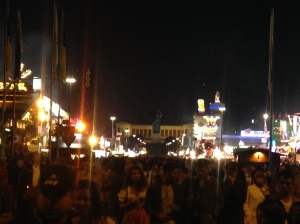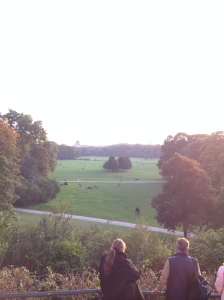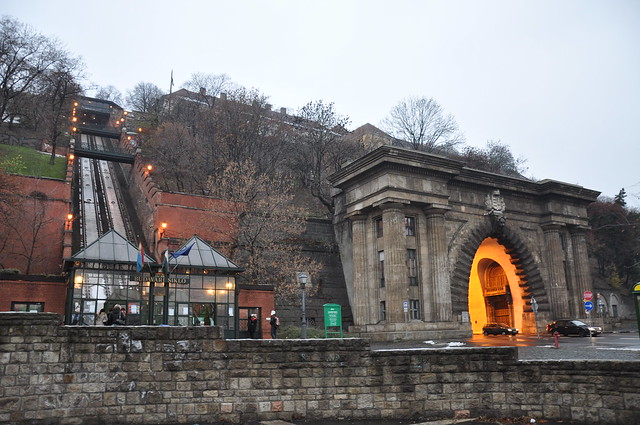We woke up Wednesday morning to the sound of children’s screams rising off the neighboring soccer field. Michael was leaving for Budapest in the early afternoon, so we briefly packed and readied our stuff for leaving, then wandered out. We strolled down the Auguststraße, looking for a place to breakfast and admiring the older buildings. The Synagogue Mitte caught my eye, and Michael explained how it was saved from the Kristallnacht destructions by one inspired guard faking a document from Hitler. I visited an Apotheke to grab some toiletries and then we went to Café Bravo, a pretty place in a courtyard which for some reason was only serving breakfast all day. After a hearty plate of eggs, bacon, and mushrooms, we went back and rested a little longer in the apartment. I’m still struggling to deal with the time difference between here and home and stopped myself from trying to carry on conversations with my friends at what would’ve been 7 am for them.
Michael had let me share his AirBNB for a night, which was great, but he was leaving and I’d be homeless. I shopped around before deciding on a hostel he recommended, the Great Hostel Berlin. It lays on Templehofer Ufer, and should’ve been a quick U-Bahn trip away from the other apartment. We went to the subway and said goodbye to each other, since he was heading for the airport, and I took off in the direction of the hostel. I found the train much more agreeable this time around – in the daylight, a little clearer of mind, I could figure out what earlier seemed a byzantine system of rails, and made it to a station close enough.
I made my first German attempt of the day asking a guy at a café which way my street was. My accent betrayed me so he answered in English at first, but I began doing a strange thing I’d do again in the day. I faked not knowing English to just use German, and he repeated his advice in that language, which I took with a thanks. But just five minutes or so later, the rain came down heavily, and I was forced into a cab, though not before a big van could cartoonishly splash water from the gutter all over my legs.
I told the cabbie where to take me, but made a fatal error: I forgot to ask if he took credit card. Looking back, I didn’t really have much choice, given the downpour, but to take his cab, but we got into a bit of a spat when we arrived at the hostel. He berated me for a little while in German, a scary thing indeed, but I recovered and in the end had to go to an ATM to grab cash before getting to the hostel. Word of advice: don’t get caught without cash in Berlin.
I checked in and was told my room wasn’t ready, so I could go explore the city and return. I chatted with an Australian father and son touring the city, who told me a bit about what to do and asked me all the ins and outs of American sports salaries. Navigating out and onto the U-Bahn again, I made my way to the middle of the city and saw a sign for the Museuminsel, and decided to check out the stuff there. It was a good decision. I’d been starved by Berlin’s grays – rows and streets full of the stuff, building after building another Brutalist monument. But the Museuminsel was different. Hues of pink, oxidized copper, and gargantuan gilted wreaths covered every building. I stood at the corner opposite the Altes Museum and the Berliner Dom and marveled at the sight. It was the Old World I was looking for, and I was happy to see it.

Altes Museum
I checked out the Altes Museum, which was nice, but rather unremarkable for someone who wasn’t super into looking at broken classical busts. Here my German began to falter: I asked a guard whether it was okay to keep my jacket on and he barked a reply full of consonants back to me. I shook my head in agreement and ran off.
The Berliner Dom, on the other hand, was a treat. It’s a colossal monument to German Protestantism, with quotes along its turrets reaffirming the love of God and statues of Calvin and Luther everywhere. I paid a student’s rate (a very cool thing about the attractions here) and entered the main cathedral. Like the outside, it was wildly colorful, with inset slabs of porphyry and marble and baroque spins of concrete and wood everywhere. The tour continued up the winding staircases, which eventually led outside on top of the biggest dome. You could see all of Berlin from up there, and I took a while strolling around it. From the top, I went next to the basement, which the building calls the Crypt of the Hohenzollerns, who were Germany’s only proper royal family. Starting in the 1420s as one of the innumerable princely families vying for control in the HRE, they seized power in much of the north of Germany and established Berlin as their capital. They would later be the same family to establish Prussia, and then through the Wars of German Unification the ones to declare the Second Reich. The Crypt contained many of their bodies, from the stillborn princesses to one of the Kaisers. It was a holy place, dimly lit and smelling of dust, and a really unexpectedly interesting diversion.
I continued my sightseeing through the Alexanderplatz, gawking at the Fernsehturm and the Mariankirche. But the day was already winding down and as I grew sluggish from the activities, so too waned my linguistic abilities.

Marienkirche am Alexanderplatz
At my nadir, I was trying to buy a European power adapter in Germany’s electronic megastore, Saturn. I lamely asked the clerk if I could pay with card and did so, but then she ramped things up, apparently asking me if I wanted a bag. The lines were choked and the fluorescent tubes were burning and I could only stammer in a weird Germanic schwa sound. She repeated it in English and I gave up and said yeah and walked out. I explored the Galeria Kaufhof silently, only going in to check if they had what I had just bought for cheaper. I came out with nothing in hand.
At that point my hunger overrode my Sprachschämen and I walked into what looked like a traditional German restaurant, identifiable by its advertising of beer with every plate of sausages and potatoes. The woman manning the restaurant was friendly and I went for German again, and this time got it off with no problems! I paid for my meal, grabbed a “small” (her words, it was pretty normal sized) beer, and happily ate the stuff. I went to the hostel afterwards reinvigorated.

My traditional German food – sausage and potatoes and beer
Later that night, I signed up to go on a pub tour with the hostel, and in doing so met a lot of cool people. Gaggles of Australians, Canadians, and British filled the room, chatting about previous and future destinations and their excitement to see Berlin’s famed nightlife. I hopped between conversations, buzzing in the crowd and getting to know people. I found a girl and guy from Dartmouth who were also studying abroad and we hung out the entire night with some British people. The pub tour fell off after one or two cramped and noisy places, so we retired to a Kebab restaurant and talked until late in the night.

Brandenburger Tor on a cloudy day
The next morning I learned that the people I was sharing the room with, a group of Australian girls, were planning to go on this walking tour of Berlin I had heard about from everyone. I had a proper German breakfast (cold meats, fruits, waffles and jams, coffee) and hopped on the Bahn (a system I was becoming intimate with) down to the Brandenburg Gate. The tour was well-hyped. Our guide, George, was an American ex-pat well-versed in the history of Berlin, from the earliest days as a Slavic fishing camp to the many crises of the Cold War. He talked and walked a mile a minute, but kept everyone’s attention well enough and showed us a lot of good stuff.1
I wrapped up my sightseeing by wandering into a few more squares, and ended up back on Friedrichstraße. I saw Dussmann, Berlin’s famous independent KulturKaufhaus, and went in with a mission to live up to this blog’s namesake. I got the title for this blog from a George Orwell book, Down and Out in Paris and London. Only by the time I set this up, I hadn’t actually read it. In the interest of not being a poser, I tried to read it before I got to Europe and wrote the first proper post, but the library near my house only had an abridged copy, and though I bought a copy when we stopped at Penn briefly on the way to JFK, I left it in the car. So I put my brave German face on again, asked a clerk where the English bookstore was, proceeded to go up the wrong set of stairs, and bought the thing (this time I knew what the word for bag was, I killed that transaction). It’s a highly recommended book, and surprisingly funny to boot. The characters Orwell experiences while being a young poor man living in a Paris slum are caricatures of national and ethnic identities, and as such, very funny. Boris, the Russian army captain turned lame waiter, is a good example, as is Fureux, the Communist by day, French patriot by night who cries when he sings La Marseillaise.2

Colorful apartments on the Lunestraße

At Mustafa’s
The last sights were taken in Berlin’s big park, the Großer Tiergarten. I began at the Reichstag and took a bus past the Siegessäule, then walked over to the Castle Bellevue (the first two were exciting, the third not so much). Since I was done sightseeing, I set a course for the hostel, but got lost. I ended up walking down a street called Lunestraße, empty of people and full of mechanic shops, to the Hauptbahnhof. On Kyle’s recommendation, I went for my last Berliner sight and ate at Mustafa’s, after waiting in line for 45 minutes.
The train to Budapest left at 6:30 and I hopped on a bus with my luggage towards the Hauptbahnhof about 5:40. That bus trip clued me into something I hadn’t seen in Berlin by foot – its sheer breadth. I was taken aback as the bus rolled through expanses of buildings, squares and gardens I had never even seen on the map. It’s a breathtaking place, and I miss it already, if only because it’s the first city in Europe wherein I felt I could have some degree of agency. The supreme English speaking abilities of the entire population notwithstanding, I was able to get an impression of belonging there, of feeling kind of at home. Language is a brutal thing when it’s exclusionary. But by learning even to read the street signs, you are brought into another culture so much more deeply. It was a great feeling, to hear German being spoken to me and to be speak it back, and hopefully at some point I’ll be able to do so in Hungary.
Anyway, the train ride was the last adventure of this 48-hour period. It was an old train, with mauve patches of carpet on the ceiling and legroom of about two feet per seat. It was also a veritable United Nations meeting – in the space of 14 hours, I spoke to Argentinians, Brazilians, Germans, Serbians, Czechs, and Russians. The two sitting across from me were the South Americans, and we talked late into the night about everything. Five hours we spent chatting, others, jealous of our fun times, gravitating in towards us. A gigantic Russian, Vladimir (also coincidentally a Siberian-raised ex-Russian army officer) sat next to me and we parleyed on American politics for an hour (the Russians see Hillary in 2016). It was a real weird time to tell the truth, but also very much in the spirit of being abroad. They all got off at Prague, still 9 hours away to Budapest, and so I slept in my uncomfortable chair the rest of the way, Eastern European raindrops soothing my senses into silence.
1. The Memorial to the Murdered Jews of Europe was an especially interesting site. It’s exemplary community art, as it lies in one of Berlin’s most well-trafficked areas and immediately catches your eye. More than 2000 irregularly shaped and sized grey stone blocks fill a square, and the ground dips and dives to form a kind of parabolic surface, so that in the middle of the monument, you’re lower than at the edges. What George acutely pointed out was the lack of information given for the place – no signs, no guards, only the smallest signs for emergency exit around. It gives you the chance to make your own meaning, and to me, it connoted pure horror. As you walk along the curve down to the bottom, the blocks rise higher above your head and they extend past you in all directions. Claustrophobia raises the hairs on your neck, and despair takes over. Your saving grace is the sky, visible through every alleyway and straight above you, but looking towards it also means you look up to the blocks, now towering at three times your size. When we’d all crossed to the other side of the square, through the alleys, George called it brilliant, and I had to agree.
2. For an extra helping of my two-penny literary break-down, I think Orwell is using a technique Dostoevsky used in The Gambler, writing characters entirely determined by their ethnicity, or creating ethnopsychologies. I refer you to the prof who taught the Dostoevsky class I for some reason dropped after a month – one of the best classes I’ve taken at Penn no doubt.





























